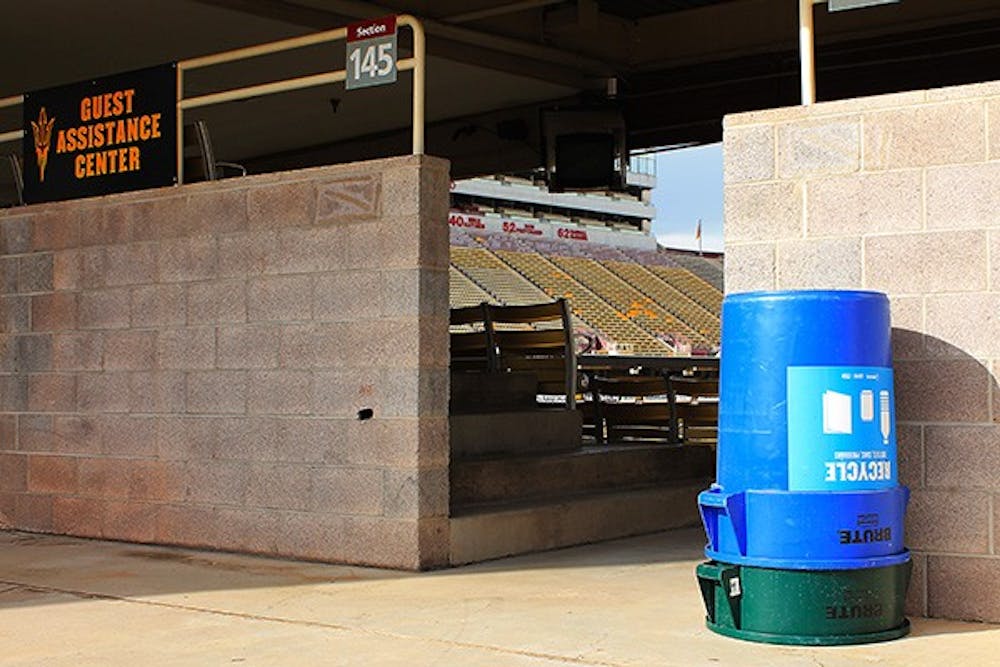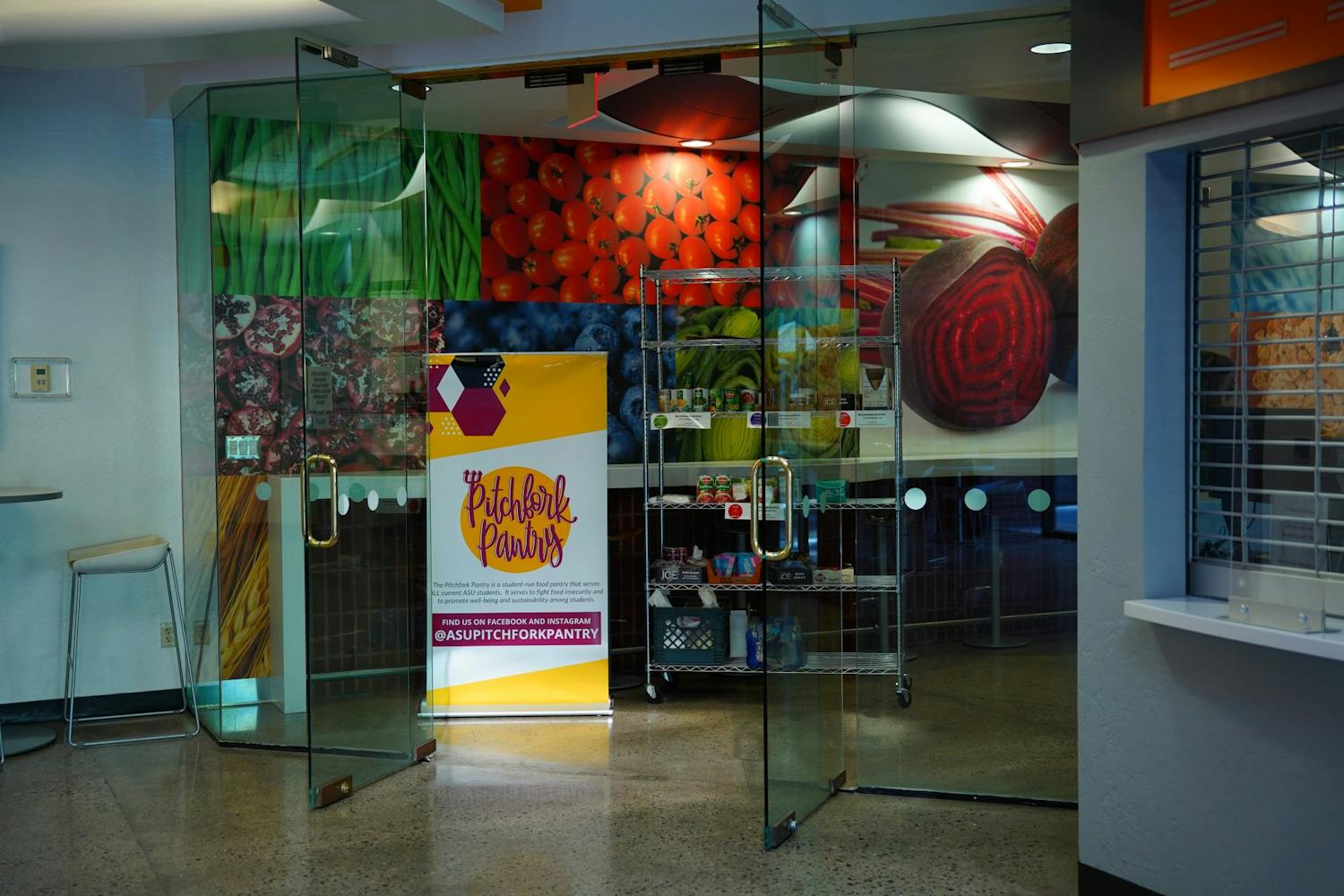 The Zero Waste Initiative uses these colored bins to segregate waste. The Zero Waste Initiative aims towards eliminating waste from all ASU campuses by 2015.(Photo by Shiva Balasubramanian)
The Zero Waste Initiative uses these colored bins to segregate waste. The Zero Waste Initiative aims towards eliminating waste from all ASU campuses by 2015.(Photo by Shiva Balasubramanian)In January 2012, ASU and Waste Management Inc. collaborated on a project called “Roadmap to Zero Solid Waste,” which aimed to eliminate waste on all the University’s campuses by 2015.
With over 70,000 students and 13,000 staff members, it is not surprising that the University produces a large amount of waste. The Global Institute of Sustainability reported that the University produced 6,778 tons of waste, a quarter of which was food, in 2012 alone.
Corey Hawkey, manager of the Zero Solid Waste initiative, said the term "zero waste" does not necessarily mean the elimination of all waste.
“Zero Waste is defined as eliminating 90 percent of the solid waste generated on campus from the landfill,” Hawkey said.
With 2015 quickly approaching, many are wondering if the ASU will meet the goal.
While all the data has not been collected to determine if the project was successful, Hawkey said the program has been successful in myriad aspects.
“The Zero Waste initiative has been successful in a variety of ways,” Hawkey said. “For example, ASU is diverting pre-consumer organic material from all Tempe dining halls. Earlier this year, we achieved over a 95 percent diversion rate at the Clinton Global Initiative University event.”
Hawkey has worked in collaboration with Alana Levine, manager of the Recycling and Solid Waste program. Together, they have coordinated more than 1,000 hours of engagement efforts across campuses, Hawkey explained.
The initiative called for extensive collection of data on a regular basis. Even before the initiative was in progress, data on solid waste had been collected, Hawkey said.
 The Zero Waste bins are set up around Sun Devil Stadium before the home game against Washington State. (Photo by Shiva Balasubramanian)
The Zero Waste bins are set up around Sun Devil Stadium before the home game against Washington State. (Photo by Shiva Balasubramanian)“ASU receives waste data on a monthly basis from solid waste haulers as they become available,” Hawkey said. “It is combined with waste information from the Recycling and Solid Waste Department at ASU. ASU has been tracking solid waste data for nearly four years.”
The program also aimed to minimize waste at sporting events. The School of Sustainability reported that each home football game last season averaged over 60,000 fans, creating 25,000 to 30,000 pounds of waste per game.
“We also placed fourth in the RecycleMania Game Day Basketball Diversion Competition by diverting over 87 percent from the ASU versus University of Arizona game,” Hawkey said. “Moreover, all athletic events are striving for zero waste.”
In order to divert waste from landfills, trash cans have been replaced with green compost bins for food, liquids, and utensils while blue recycling bins are designated for bottles, cans, and paper programs.
Waste Management has provided collection, processing, recycling and transport services of waste materials to ASU since 2007 and continues to be a vital element in this program, Hawkey said.
“Waste Management has been a great partner to ASU to get the program off the ground. At this time, they are ASU's primary solid waste hauler and processor,” Hawkey said. “They process and handle our blue bin co-mingled recycling and green bin composting.”
The initiative extends much further beyond the bin. While adapting to recycling and composting efforts might seem easy, being able to reuse and repurpose everyday items is a new concept to most.
The initiative requires students to focus on three main elements of their daily lives: rethinking waste, convenience, and their role, Hawkey explained.
“(Students) must challenge themselves to rethink what they throw away in order to find alternative products or find reuse or other recovery solutions for that item,” Hawkey said. “It could be just as convenient to carry your own reusable beverage container, reusable utensils and reusable towels as it would be to use disposables all the time. (Students) must seek out the necessary information to participate fully in ASU’s diversion programs and to share that knowledge with their peers.”
Sustainability senior Alen Jakupovic said he believes the initiative will be successful despite the struggle to raise awareness.
“Even with the deadline approaching, I believe the initiative will be successful. However, it takes managing from the bottom up,” Jakupovic said. “Since lower positions make up a majority of the strategy, they need to make it known that they support the project.”
Jakupovic said if he were in charge, he would have involved a lot of awareness outside of sustainability majors at the spearhead of the project.
“Initially, the only people involved with the project were sustainability majors. Due to internal marketing, sustainability students and teachers knew about (zero waste) more than anyone.” Jakupovic said. “It’s not pushed under people’s noses enough and can still be ignored by others.”
Psychology freshman Courtney Cabral said the Zero Waste initiative has not been encouraged enough.
“I only somewhat see (the initiative) being encouraged, but I think there are enough ways to recycle on campus to make a difference,” Cabral said.
Jakupovic elaborated on several other projects established on campus aimed to keep the zero waste goal alive.
“Campus Student Sustainability Initiative is a two-part green team. We are a student-led initiative that aims to make the campus more sustainable,” Jakupovic said. “The initiative is composed of volunteer groups that go to events and a project-orientated group, which focuses on water conservation efforts by advocating for the establishment of double-flush toilets on campus.”
Achieving the goal of zero solid waste will take the collaboration and participation between each student and staff member, making this initiative one of the largest the University has ever seen.
Hawkey advocated the importance of continuing the practice of zero waste, even once 2015 comes and goes.
“Zero waste is an initiative that will be ingrained into the culture at ASU,” Hawkey said. “For zero waste to be truly successful in the long-term, it needs to be integrated into all facets of the University through participation of students, faculty, staff and guests.”
Although ASU has laid the foundation for a successful future, Hawkey stated the entire community must be involved for the University to be successful.
“Zero waste is an ambitious goal that requires innovation and participation from the entire ASU community,” Hawkey said. “ASU has succeeded in making strides to provide additional diversion opportunities and has laid a solid foundation for future efforts to continue to move toward zero waste.”
Reach the reporter at Jlsuerth@asu.edu or on Twitter at @SuerthJessica.
Like The State Press on Facebook and follow @statepress on Twitter.




